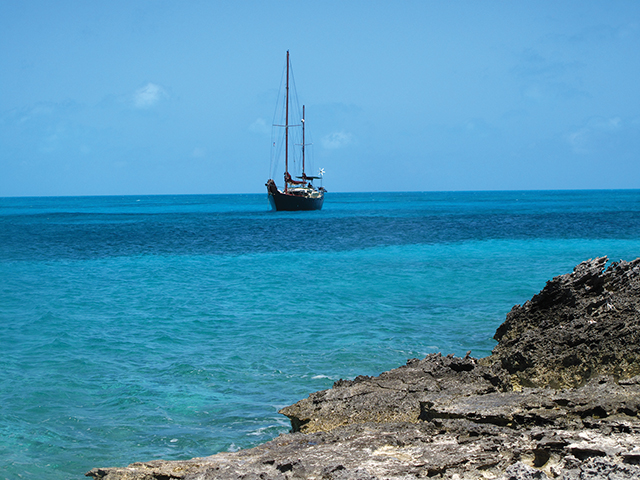A cruiser in Cuba experiences a close encounter of the predator kind (published November 2012)
We were anchored in a lovely spot in the lee of Cayo Sal on the south coast of Cuba. The islet, a mere rock about 50 nautical miles offshore, is no more than sharp limestone raised a couple of meters above sea level. We had just left the city of Cienfuegos and were on our way to Cayo Largo. The weather being favorable, we decided to stop in the cays for a few days to fish, explore and relax. No other boats were around and we were enjoying the place by ourselves. We were three on board the 53-foot steel ketch Karaka, with my girlfriend Kim and a crew member from Canada named Brandon who had joined us only a week prior.
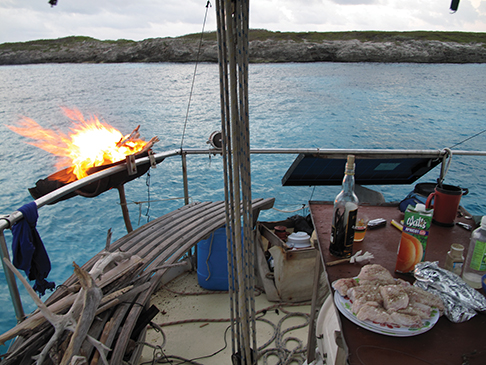
On the second day, we enjoyed the last filet of a massive grouper we caught the previous day for lunch, and that afternoon I decided to catch some lobsters for dinner. I went swimming with my spear gun while Brandon followed me in a kayak. Kim stayed on Karaka by herself. As we were getting on our way, a charter catamaran showed up and anchored about a mile away. I swam half a mile to the western tip of the island without seeing anything that qualified as dinner. The current was strong and I was moving very slowly. The bottom was flat sand and short weeds, with nothing around but a few turtles and the usual bunch of barracudas. I was keen on catching some lobsters, so I told Brandon I wanted to swim toward the reef, a good 600 feet more against the tide. In the meantime, Brandon went to take pictures of a wrecked catamaran lying on the reef not far away. While he was gone, two big trevally jacks—excellent food in that part of the world—swam by. I shot one.
My spear did not kill the 20-pounder. He started bleeding profusely and struggling madly, and the second fish was getting frantic as well. Brandon was fairly far away, so I decided to head for the shore, about 150 feet away, in order to get the fish out of the water. I was at the surface, over a flat bottom about 15 feet deep. Before I could go anywhere, a massive barracuda entered the scene.
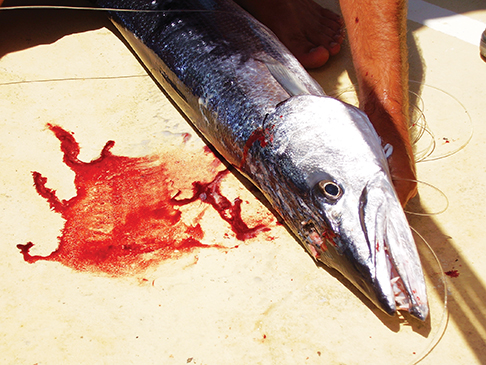 FEEDING FRENZY
FEEDING FRENZY
The barracuda immediately started grabbing chunks of the fish at the end of my spear, 12 feet away. I tried to swim away from the carnage, but the second distressed trevally figured I was less dangerous than the barracuda and tried to hide between my arms. I grabbed the fish and threw him away, but as I extended my arm, the barracuda darted in and took my left forearm in his jaws.
I’ve still got nightmares about that moment. I pulled my left arm out of the water and tried to get the barracuda off me with my right hand, but he was gnawing at me with all he had. I could hear his teeth grinding on my bones. He finally let go, ripping off a chunk of flesh about two inches wide and leaving the bone exposed. Oddly, it wasn’t painful right away, but the situation was desperate. I was in the water alone, 150 feet from shore, with blood spurting from a huge wound at every heartbeat. At the same time, the five-foot-long barracuda, having enjoyed a mouthful of me, was eager for more and probably yelling to his friends that I was pretty tasty.
I covered the wound and tried to stop the bleeding with my palm while I started swimming toward the shore, yelling like a maniac. Both Brandon and Kim heard me. Brandon started paddling toward me as fast as he could, but Kim was half a mile away and could not assist me, as the dinghy was secured on deck. I made it to shore without being attacked a second time, probably because all the barracudas were fighting for the dying trevally.
The shore was a cliff of barnacle-covered limestone—the sharpest, most dangerous thing to climb even in normal situations—and there was substantial swell crashing into it. I made it, though I can’t figure out how. I remember lots of blood and kicking my fins off, but nothing else. Once on dry land I took a look at my arm, saw my own bone and blood spraying from my severed artery, realized where I was, and understood that I was a dead man. When something like this dawns on you, strangely you feel at peace. But immediately, survival instincts kicked in and I started yelling and running toward Karaka, holding my wound closed with my other hand. I hadn’t given up yet.
Brandon came nearby, but there was nowhere to land. Kim didn’t have any means to come get me, and there was nobody else around, except the charter catamaran, which was out of sight around the corner. Brandon got the kayak as close as possible and I jumped in, but not being clearheaded at that point, I tipped the boat over. Brandon managed to right the kayak while I climbed on a nearby rock. The second try was successful, and I sat in front of Brandon as he paddled. The kayak was riding low with two passengers and we were sitting in a pool of blood and water. Halfway back to Karaka, I started to go into shock and almost tipped the boat again, but Brandon managed to keep her upright. A school of barracudas were following us by then, attracted to the blood.
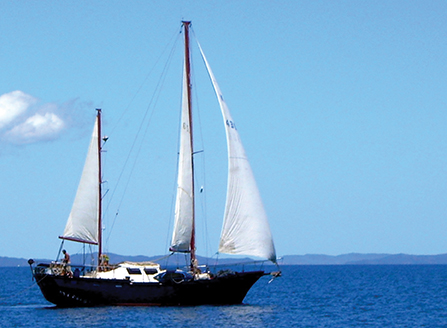 We made it back to Karaka, where Kim had prepared the first aid kit, boiled some water and cleared the deck. As I climbed on board and lay down, she got a compress and put it on my wound to try to stop the bleeding. Brandon had recently renewed his first aid certificate, so he managed to save my life by doing all the right things while Kim was busy trying to get help on the radio. We managed to stop the bleeding, but I started to feel the pain and was in shock from the severe blood loss. Nobody answered the radio, so Kim went on the kayak to the charter boat. Once she got there, she had to wait for the Cuban captain, who was out spear fishing for lobsters, while the German tourists tried to understand what had happened. Once back on his boat, the Cuban captain immediately called the authorities in Cayo Largo for medical help. The marina answered and sent a boat out. In the time it took the doctor to arrive, the catamaran rafted alongside our boat, bringing Kim back.
We made it back to Karaka, where Kim had prepared the first aid kit, boiled some water and cleared the deck. As I climbed on board and lay down, she got a compress and put it on my wound to try to stop the bleeding. Brandon had recently renewed his first aid certificate, so he managed to save my life by doing all the right things while Kim was busy trying to get help on the radio. We managed to stop the bleeding, but I started to feel the pain and was in shock from the severe blood loss. Nobody answered the radio, so Kim went on the kayak to the charter boat. Once she got there, she had to wait for the Cuban captain, who was out spear fishing for lobsters, while the German tourists tried to understand what had happened. Once back on his boat, the Cuban captain immediately called the authorities in Cayo Largo for medical help. The marina answered and sent a boat out. In the time it took the doctor to arrive, the catamaran rafted alongside our boat, bringing Kim back.
LIFEBOAT
Cayo Largo was roughly 25 nautical miles away, so it took an hour-and-a-half for the boat to arrive. During that time, I came out of shock. We decided that Kim would come with me and Brandon would remain to take care of Karaka. I got my mind off my pain by coaching Brandon on everything he needed to know. There was a storm coming and we knew that this anchorage would be critical in a few days, but we assured Brandon that Kim would be back with an experienced captain to take the boat to safety before it was too late.
The rescue boat wasn’t an ambulance, but a sport fishing boat with one doctor, a simple first aid kit and no serious revival gear. He had no blood on board, but he did have plasma. He tried to give me a transfusion, but the boat was rolling too much. After ruining my inner arm and growing seasick, he gave up. I was pretty much stable by then, and fully conscious. The medic decided that given the conditions, he shouldn’t do much until we arrived at the clinic in Cayo Largo. About one hour into the trip I had the pressing need to urinate, so they handed me an empty can and left me alone. Big mistake. As I was doing my business, something burst and I started spurting blood all over the place again. By the time I got the attention of the medic over the noise of the engine, I was lying in a puddle of blood. He managed to stop the bleeding, but we learned later that I should have died then and there. Apparently I have a very high hemoglobin count, which means I have a lot of red cells, and that enabled me to survive the heavy blood loss.
When we finally arrived at the dock, they transferred me to the nearby clinic and fixed me up. They don’t allow drugs in Cuba, so unfortunately I didn’t have the blessing of morphine or any kind of anesthetic. The pain while they were cleaning and clamping my open artery was the most severe I have ever experienced. I managed not to pass out, but my yells were heard far and wide. Fortunately, Cuba has one of the best health care systems in the world, and although they lack supplies, they are extremely efficient and competent. They didn’t have blood in Cayo Largo either, but they garroted my arm and sent me on a military plane to La Havana, where I got an operation the same night. They fixed my severed tendons, my open artery and my muscles, and stitched it all up under full anesthesia. They couldn’t fix my nerve because I was missing more than two inches of it and it needed a graft, an operation that can only be done after the wound has healed a bit.
While I was in the hospital, Kim got the help of several yachties in the marina to go get Karaka and Brandon. Thankfully, they docked my boat safely in the marina a mere 24 hours before the storm hit. After a week in the hospital I was released and spent a week in Cayo Largo before heading back to Havana for the second operation involving the nerve graft.
FISH FOOD
It’s now been a few years and I am almost entirely recovered. I got a wicked scar, and while I lost some use and feeling in my left hand, I can still use the hand well. I never left Karaka during my convalescence but kept cruising, and we sailed out of Cuba a few weeks after my last operation. We then sailed around the Caribbean again, down to Panama and Colombia, and back north for the next season, spending another couple of months in Cuba. I never found my spear gun again, nor my fins and mask, but I managed to get myself back in the water. Although it took me a couple of years to remain calm in the presence of barracudas, I am now able to go spear fishing again.
I learned some lessons from this accident, but nothing I wasn’t really aware of before. The main one is to never go spear fishing alone. If somebody had been with me in the water, he or she would have been able to shoot the barracuda before the situation got bad. The second thing is that it is a grave mistake to be spear fishing away from a boat. If Brandon had been nearby with the kayak, I could have gotten out of the water immediately. As for being in the middle of nowhere, well, that’s a risk you take when you go sailing. The radio was working—we were just out of range. The charter boat had a satellite phone and that made the difference.
The barracuda did not attack me. It was clearly a freak accident. His prey was the trevally, and it is only by mistake that the barracuda bit my arm. He was going for the other fish, but I moved the fish away and put my arm in its place. I can’t blame the barracuda, and I don’t see any reason to be scared of them. They have earned my respect and I understand them better now. I have learned to interpret their mood and to anticipate their reactions. On the other hand, I have to admit to feeling good after killing my first barracuda when I went back to Cuba. That first mouthful of his flesh was delicious…revenge can sometimes be as sweet as fresh fish.
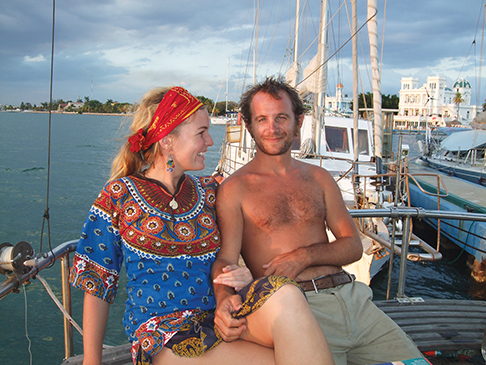 Tom and the Karaka crew left the Caribbean through the Panama Canal and are currently cruising in the sea of Cortez on the Pacific coast of Mexico. They are about to set sail toward Costa Rica and the Galapagos, before making the jump toward Polynesia. There will be crew positions available on Karaka, so if you are interested, visit karaka.voila.net for more info.
Tom and the Karaka crew left the Caribbean through the Panama Canal and are currently cruising in the sea of Cortez on the Pacific coast of Mexico. They are about to set sail toward Costa Rica and the Galapagos, before making the jump toward Polynesia. There will be crew positions available on Karaka, so if you are interested, visit karaka.voila.net for more info.















